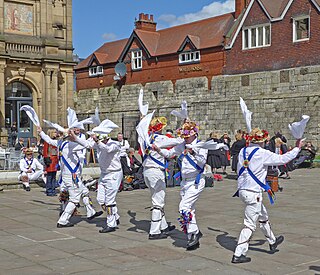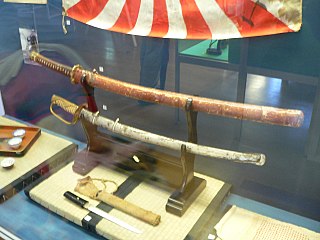| Look up longsword in Wiktionary, the free dictionary. |
A longsword is a type of European two-handed sword.
Contents
Longsword may also refer to:
| Look up longsword in Wiktionary, the free dictionary. |
A longsword is a type of European two-handed sword.
Longsword may also refer to:
| This disambiguation page lists articles associated with the title Longsword. If an internal link led you here, you may wish to change the link to point directly to the intended article. |
A sword is a bladed melee weapon intended for cutting or thrusting that is longer than a knife or dagger, consisting of a long blade attached to a hilt. The precise definition of the term varies with the historical epoch or the geographic region under consideration. The blade can be straight or curved. Thrusting swords have a pointed tip on the blade, and tend to be straighter; slashing swords have a sharpened cutting edge on one or both sides of the blade, and are more likely to be curved. Many swords are designed for both thrusting and slashing.

Morris dancing is a form of English folk dance usually accompanied by music. It is based on rhythmic stepping and the execution of choreographed figures by a group of dancers, usually wearing bell pads on their shins. Implements such as sticks, swords and handkerchiefs may also be wielded by the dancers. In a small number of dances for one or two people, steps are near and across a pair of clay tobacco pipes laid one across the other on the floor. They clap their sticks, swords, or handkerchiefs together to match with the dance.
A longsword is a type of European sword characterized as having a cruciform hilt with a grip for two-handed use, a straight double-edged blade of around 85 to 110 cm, and weighing approximately 1 to 1.5 kg.

Sword dances are recorded throughout world history. There are various traditions of solo and mock-battle (Pyrrhic) sword dances from Africa, Asia and Europe.

The Long Sword dance is a hilt-and-point sword dance recorded mainly in Yorkshire, England. The dances are usually performed around Christmas time and were believed to derive from a rite performed to enable a fruitful harvest.
Swordsmanship or sword fighting refers to the skills of a swordsman, a person versed in the art of the sword. The term is modern, and as such was mainly used to refer to smallsword fencing, but by extension it can also be applied to any martial art involving the use of a sword. The formation of the English word "swordsman" is parallel to the Latin word gladiator, a term for the professional fighters who fought against each other and a variety of other foes for the entertainment of spectators in the Roman Empire. The word gladiator itself comes from the Latin word gladius, which is a type of sword.

The kampilan is a type of single-edged sword, traditionally used by various ethnic groups in the Philippine archipelago. It has a distinct profile, with the tapered blade being much broader and thinner at the point than at its base, sometimes with a protruding spikelet along the flat side of the tip. The design of the pommel varies between ethnic groups, but it usually depicts either a bakunawa (dragon), a buaya (crocodile), a kalaw (hornbill), or a kakatua (cockatoo).

Historical European martial arts (HEMA) are martial arts of European origin, particularly using arts formerly practised, but having since died out or evolved into very different forms.

An ōdachi (大太刀) or nodachi was a type of traditionally made Japanese sword used by the samurai class of feudal Japan. The Chinese equivalent and 'cousin' for this type of sword in terms of weight and length is the miao dao, and the Western battlefield equivalent is the longsword or claymore.

The English language terminology used in the classification of swords is imprecise and has varied widely over time. There is no historical dictionary for the universal names, classification or terminology of swords; A sword was simply a double edged knife.

Sir William Longespée was an English knight and crusader, the son of William Longespée and Ela, Countess of Salisbury. His death became of significant importance to the English psyche, having died at the Battle of Mansurah, near Al-Mansurah in Egypt.

In martial arts, a waster is a practice weapon, usually a sword, and usually made out of wood, though nylon (plastic) wasters are also available. The use of wood or nylon instead of metal provides an economic and safe option for initial weapons training and sparring, at some loss of genuine experience. A weighted waster may be used for a sort of strength training, making the movements of using an actual sword comparatively easier and quicker. Wasters as wooden practice weapons have been found in a variety of cultures over a number of centuries, including ancient China, Ireland, Iran, Scotland, Rome, Egypt, medieval and renaissance Europe, Japan, and into the modern era in Europe and the United States. Over the course of time, wasters took a variety of forms not necessarily influenced by chronological succession, ranging from simple sticks to clip-point dowels with leather basket hilts to careful replicas of real swords.

The Zweihänder, also Doppelhänder ('double-hander'), Beidhänder ('both-hander'), Bihänder or Bidenhänder, is a large two-handed sword primarily in use during the 16th century.
The katana sword appears in many folk tales as well as legends. This piece of Japanese history not only appears in old folklore, it is also very popular in modern fiction as well as contemporary art pieces such as film and theater. The katana has reached far and wide in the world of fictional stories and can be used to tell tales of wisdom and bravery or evil and treachery. The sword can be seen not only as a tool for the hero but also a tool for the villain.

Japanese swordsmithing is the labour-intensive bladesmithing process developed in Japan for forging traditionally made bladed weapons (nihonto) including katana, wakizashi, tantō, yari, naginata, nagamaki, tachi, uchigatana, nodachi, ōdachi, kodachi, and ya (arrow).
A katana is a Japanese sword characterized by a curved, single-edged blade with a circular or squared guard and long grip to accommodate two hands. It was used by the samurai of ancient and feudal Japan.

The guntō was a ceremonial sword produced for the Imperial Japanese army and navy after the introduction of conscription in 1872.
In the European High Middle Ages, the typical sword was a straight, double-edged weapon with a single-handed, cruciform hilt and a blade length of about 70 to 80 centimetres. This type is frequently depicted in period artwork, and numerous examples have been preserved archaeologically.